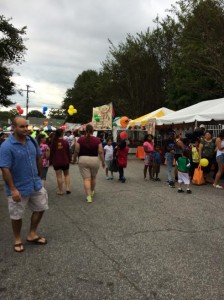Hispanic Festival Highlights Culture
More than 30 Winston-Salem residents took off running down Holly Avenue with members of the Camel City Thrashers, a local roller derby squad, in hot pursuit waving pool noodles filled with colored powder. The chase down Holly Avenue is based on a Spanish tradition of the running of the bulls that has expanded into Latin America and features participants running in front of a small group of bulls down city streets.
“My favorite event was the running of the bulls. It was a really clever way to engage members of the community,” said Annie Price, 17, a volunteer for the event.
The running of the bulls is the newest addition to the city’s annual Fiesta, a festival of food, music and craft that recognizes the local Hispanic community. The 22nd annual Winston-Salem Fiesta took place Saturday, Sept. 13. Vendors under colorful tents promoted their crafts and artwork, sold retail ite ms and offered food for sale on Fourth Street and Poplar Street.
ms and offered food for sale on Fourth Street and Poplar Street.
The Forsyth County Hispanic League has hosted the event since the organization’s inception two decades ago. “The Hispanic League’s goal as an organization is to build bridges around multiculturalism, starting with our annual Fiesta,” said Ann Hollingsworth, who works in the League’s office. “The event is both a way to share the beauty and diversity of immigrants’ cultures from many different Latin American countries and to provide funding for over 250 college scholarships.”
Two blocks from the running of the bulls, men in traditional dress perform the same ceremonies as the ancient Aztecs. Nearby, couples competed against one another in Latin dances that include salsa and merengue at Winston Square Park. The Fiesta Dance Competition remained one of the event’s most well-attended attractions, drawing a crowd of hundreds to the stage featuring classic and contemporary Latin music hits.
Many attendees point to the food as being at the heart of the event. Vendors sold traditional food from countries such as Mexico, Brazil, Cuba and other Caribbean nations. One of the longest lines was for a small tent serving Mexican street food, particularly elote, a twist on corn on the cob with salt, chili powder, butter and mayonnaise added. “The Fiesta allows [vendors] to offer food from their culture to people who might not otherwise get to try traditional cuisine,” said Mina Vasquez, 31, the stand’s proprietor. “It also helps to promote our businesses.”
The Fiesta remains the largest Latin American-themed festival in the Piedmont Triad with over 25,000 people attending according to figures released by the Hispanic League. “I have gone to Fiesta for two years now and I’m glad to see it keep growing,” said Amelia Knight, 22, who was attending the event with friends.
Knight and others said that they could notice that this year’s Fiesta represented more Latin American countries than in previous years. Instead of just those representing Mexican culture, vendors offering goods ranging from Brazilian food to Puerto Rican crafts were present. The larger turnout at the festival compared to previous years represents a shift in the demographics that the city has experienced over the past decade according to census data. Forsyth County’s Hispanic population has grown considerably in recent years, primarily concentrated south of downtown and the northwest of the city.
Between 2000 and 2013, the Hispanic population has increased from 19,577 to 44,791 people, and has nearly doubled its size as a percent of total population according to government census data. While people of Mexican descent continue to make up approximately 60 percent of the Hispanic population, the community has become increasingly diverse, specifically with an influx of Puerto Rican, Dominican and Central American immigrants. The largest influx, however, occurs from Hispanic citizens born in the United States and moving from other states.
Fiesta organizers captured the diversity in the city’s Hispanic population with a board showing flags from Latin American countries. Volunteers handed out stickers for people to place under flags depicting their country of origin.
“As someone of Honduran descent, I appreciated that the festival included representation from across Latin America,” Knight said.
By the end of the afternoon, every flag was dotted with multiple round orange stickers. The most popular choice? The American flag.
